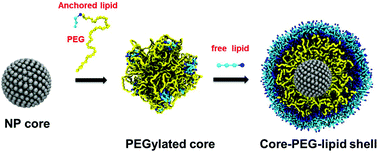Self-assembly of core-polyethylene glycol-lipid shell (CPLS) nanoparticles and their potential as drug delivery vehicles†
Abstract
Herein a new multifunctional formulation, referred to as a core-polyethylene glycol-lipid shell (CPLS) nanoparticle, has been proposed and studied in silico via large scale coarse-grained molecular dynamics simulations. A PEGylated core with surface tethered polyethylene glycol (PEG) chains is used as the starting configuration, where the free ends of the PEG chains are covalently bonded with lipid molecules (lipid heads). A complete lipid bilayer is formed at the surface of the PEGylated particle core upon addition of free lipids, driven by the hydrophobic properties of the lipid tails, leading to the formation of a CPLS nanoparticle. The self-assembly process is found to be sensitive to the grafting density and molecular weight of the tethered PEG chains, as well as the amount of free lipids added. At low grafting densities the assembly of CPLS nanoparticles cannot be accomplished. As demonstrated by simulations, a lipid bud/vesicle can be formed on the surface when an excess amount of free lipids is added at high grafting density. Therefore, the CPLS nanoparticles can only be formed under appropriate conditions of both PEG and free lipids. The CPLS nanoparticle has been recognized to be able to store a large quantity of water molecules, particularly with high molecular weight of PEG chains, indicating its capacity for carrying hydrophilic molecules such as therapeutic biomolecules or imaging agents. Under identical size and surface chemistry conditions of a liposome, it has been observed that the CPLS particle can be more efficiently wrapped by the lipid membrane, indicating its potential for a greater efficiency in delivering its hydrophilic cargo. As a proof-of-concept, the experimental realization of CPLS nanoparticles is explicitly demonstrated in this study. To test the capacity of the CPLS to store small molecule cargo a hydrophilic dye was successfully encapsulated in the particles’ water soluble layer. The results of this study show the power and potential of simulation-driven approaches for guiding the design of more efficient nanomaterial delivery platforms.


 Please wait while we load your content...
Please wait while we load your content...